Related Research Articles
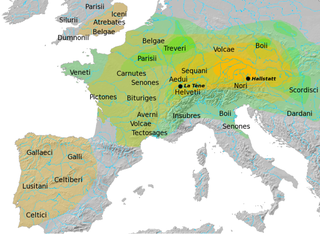
The Boii were a Celtic tribe of the later Iron Age, attested at various times in Cisalpine Gaul, Pannonia, present-day Bavaria, in and around present-day Bohemia, parts of present-day Slovakia and Poland, and Gallia Narbonensis.

The Battle of Cannae was a key engagement of the Second Punic War between the Roman Republic and Carthage, fought on 2 August 216 BC near the ancient village of Cannae in Apulia, southeast Italy. The Carthaginians and their allies, led by Hannibal, surrounded and practically annihilated a larger Roman and Italian army under the consuls Lucius Aemilius Paullus and Gaius Terentius Varro. It is regarded as one of the greatest tactical feats in military history and one of the worst defeats in Roman history.
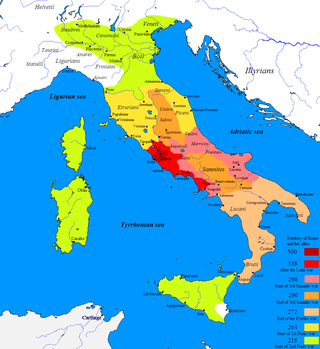
The First, Second, and Third Samnite Wars were fought between the Roman Republic and the Samnites, who lived on a stretch of the Apennine Mountains south of Rome and north of the Lucanian tribe.

Lucius Cornelius Scipio Barbatus was one of the two elected Roman consuls in 298 BC. He led the Roman army to victory against the Etruscans near Volterra. A member of the noble Roman family of Scipiones, he was the father of Lucius Cornelius Scipio and Gnaeus Cornelius Scipio Asina and great-grandfather of Scipio Africanus.

The Battle of the Allia was a battle fought c. 387 BC between the Senones – a Gallic tribe led by Brennus, who had invaded Northern Italy – and the Roman Republic.
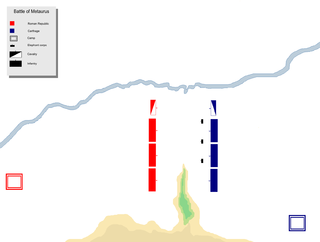
The Battle of the Metaurus was a pivotal battle in the Second Punic War between Rome and Carthage, fought in 207 BC near the Metauro River in Italy. The Carthaginians were led by Hasdrubal Barca, brother of Hannibal, who was to have brought siege equipment and reinforcements for Hannibal. The Roman armies were led by the consuls Marcus Livius, who was later nicknamed the Salinator, and Gaius Claudius Nero.
The Battle of Sentinum was the decisive battle of the Third Samnite War, fought in 295 BC near Sentinum, in which the Romans overcame a formidable coalition of Samnites, Etruscans, and Umbrians and Senone Gauls. The Romans won a decisive victory that broke up the tribal coalition and paved the way for the Romans' complete victory over the Samnites. The Romans involved in the battle of Sentinum were commanded by consuls Publius Decius Mus and Quintus Fabius Maximus Rullianus.
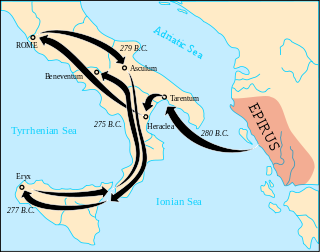
The Pyrrhic War was largely fought between the Roman Republic and Pyrrhus, the king of Epirus, who had been asked by the people of the Greek city of Tarentum in southern Italy to help them in their war against the Romans.

The Senones or Senonii were an ancient Gallic tribe dwelling in the Seine basin, around present-day Sens, during the Iron Age and the Roman period.

The Battle of Telamon was fought between the Roman Republic and an alliance of Celtic tribes in 225 BC. The Romans, led by the consuls Gaius Atilius Regulus and Lucius Aemilius Papus, defeated the Celts led by the Gaesatae kings Concolitanus and Aneroëstes. This removed the Celtic threat from Rome and allowed the Romans to extend their influence over northern Italy.
The Battle of Arretium, which was probably fought in 284 BC, is a poorly documented event in the history of the Roman Republic because it occurred in a period for which some of the books of the History of Rome by Livy, the most thorough ancient historian for early Rome, have been lost. The battle is only explicitly referred to in a text by Polybius, the ancient Greek historian, which does not give much detail and puts it in the context of other events. A text by Appian talks about these events, but does not make any explicit reference to the Battle of Arretium. It was fought between the Romans and the Gauls of northern Italy, who may have been from the Senone tribe.
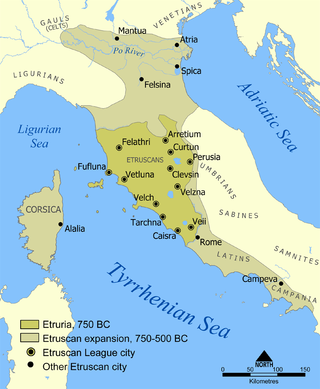
The second Battle of Lake Vadimo was fought in 283 BC between Rome and the combined forces of the Etruscans and the Gallic tribes of the Boii and the Senones. The Roman army was led by consul Publius Cornelius Dolabella. The result of the battle was a Roman victory.
The military of Carthage was one of the largest military forces in the ancient world. Although Carthage's navy was always its main military force, the army acquired a key role in the spread of Carthaginian power over the native peoples of northern Africa and southern Iberian Peninsula from the 6th century BC and the 3rd century BC. Carthage's military also allowed it to expand into Sardinia and the Balearic Islands. This expansion transformed the military from a body of citizen-soldiers into a multinational force composed of a combination of allies, citizens and foreign mercenary units.
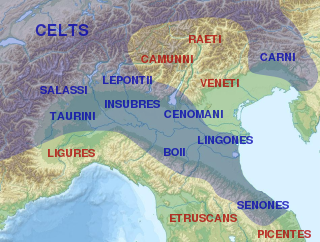
The Insubres or Insubri were an ancient Celtic population settled in Insubria, in what is now the Italian region of Lombardy. They were the founders of Mediolanum (Milan). Though completely Gaulish at the time of Roman conquest, they were the result of the fusion of pre-existing Ligurian and Celtic population with Gaulish tribes.
The Gaesatae or Gaesati were a group of Gallic mercenary warriors who lived in the Alps near the river Rhône and fought against the Roman Republic at the Battle of Telamon in 225 BC.
Publius Cornelius Dolabella was a consul of the Roman Republic in 283 BC. He is best noted for having defeated a combined force of the Etruscans, and the Boii and the Senones, two of the Gallic tribes of northern Italy, at the Battle of Lake Vadimon of 283 BC. Appian named him the leader of the expedition which devastated the Ager Gallicus and expelled the Senones from their land. This episode was also recorded by Polybius. In Polybius' text this happened before the battle of Lake Vadimon. In Appian's text it is unclear and might have happened afterwards.
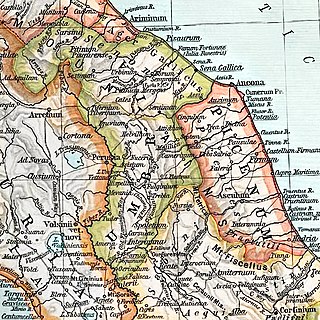
The Ager Gallicus was the territory in northern Picenum that had been occupied by the Senone Gauls and was conquered by Rome in 284 BC or 283 BC, either after the Battle of Arretium or the Battle of Lake Vadimon.

Roman Republican governors of Gaul were assigned to the province of Cisalpine Gaul or to Transalpine Gaul, the Mediterranean region of present-day France also called the Narbonensis, though the latter term is sometimes reserved for a more strictly defined area administered from Narbonne. Latin Gallia can also refer in this period to greater Gaul independent of Roman control, covering the remainder of France, Belgium, and parts of the Netherlands and Switzerland, often distinguished as Gallia Comata and including regions also known as Celtica, Aquitania, Belgica, and Armorica (Brittany). To the Romans, Gallia was a vast and vague geographical entity distinguished by predominately Celtic inhabitants, with "Celticity" a matter of culture as much as speaking gallice.

Over the course of nearly four centuries, the Roman Republic fought a series of wars against various Celtic tribes, whom they collectively described as Galli, or Gauls. Among the principal Gallic peoples described as antagonists by Greek and Roman writers were the Senones, Insubres, Boii, and Gaesatae.
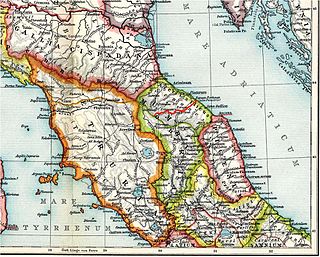
The Battle of Silva Litana was an ambush that took place in a forest 75 miles northwest of the Roman city of Ariminum during the Second Punic War in 216 BC. The Gallic Boii surprised and destroyed a Roman army of 25,000 men under the consul-elect Lucius Postumius Albinus and destroyed the Roman army, with only ten men surviving the ambush, a few prisoners were taken by the Gauls and Postumius was killed, his corpse was decapitated and his skull was covered with gold and used as a ceremonial cup by the Boii. News of this military disaster, reaching Rome probably after the election of consuls for 215 BC in Spring 215 BC or after the defeat at Cannae in the fall of 216 BC, triggered a renewed panic in Rome and forced the Romans to postpone military operations against the Gauls until the conclusion of the Second Punic War. Rome decided to focus on defeating Hannibal and sent only two legions to guard against any possible Gallic attack, however, the Boii and Insubres did not attack the Romans to exploit their victory. Cisalpine Gaul remained in relative peace until 207 BC, when Hasdrubal Barca arrived in Cisapline Gaul with his army from Spain.